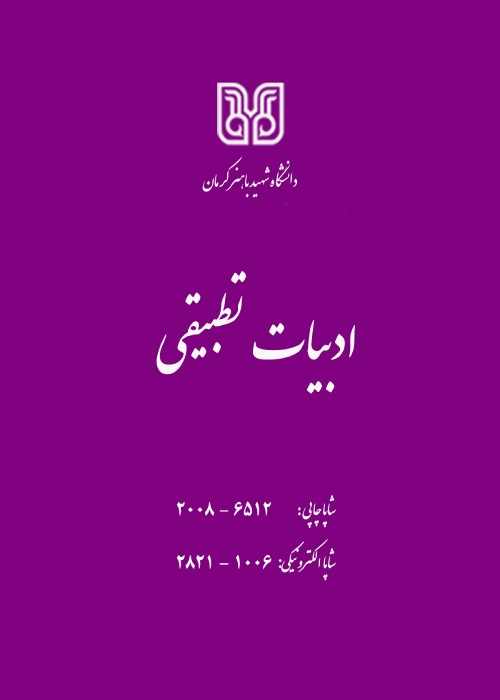A Comparative Study of Bayazid and Roozbehan Baqli's Ascensions with Fairclough's Critical Discourse Analysis Approach
Critical discourse analysis explains about how and why discourse is produced. Mystics intuitively obtain a unique language that needs to be deciphered, which is "the product of ideology" (Vodak,2001: 115). Bayazid and Roozbehan have also produced and recreated their distinct mystical discourse according to their ideology by choosing specific words and syntax. This study aims to answer this main question: How did the two mystics represent their mystical world and circumstances? Furthermore, to show possible differences and similarities.
In this research, with the analytical-comparative method and based on the analysis of Fairclough's critical discourse, the ascension of Bayazid Bastami and Roozbehan Baqli has been analyzed. Based on this, three paragraphs of Bayazid and Roozbehan Baqli's Ascension Letter have been selected as a textual body. Then the authors' critical language is analyzed and interpreted in verbal and cryptic signs. Fairclough offers a ten-question model for descriptive-level text analysis to reveal the implications of language. The first seven questions are based on empirical, relational and expressive values that the formal features of the text have. Words or syntactic constructions show empirical, relational, and expressive values. These values have an abstract, practical or action meaning. The eighth question deals with the coherence of in-text and out-of-text. The ninth question examines the interactive systems in discourse, and the tenth question deals with the structure of the text in advancing the author's goals.
At the description levelThe words "looking with the truth, seeing the truth with the truth" show Bayazid's attempt to destroy egoism. Bazid pays much attention to God. He thinks of the destruction of ego. The Ascension is based on a revelation he saw in his youth. His revelations are formed in the state of sleep, sleep and wakefulness or awakening.3-2. At the level of interpretationBayazid shows that every action has a proportionate reaction. There are a lot of declarative sentences and active in his words, so he is able, not defeated. Roozbehan Baqli also claims that a needle from God has been opened on him. He has advanced in the stage of purification. Roozbehan saw the sea, the island and the palace of Quds differently before his Ascension, but after his Ascension (the state he has experienced), he sees the sea, the island and the palace of Quds as one. In his ascension letter, God, angels and Khidr are present. The dialogue between God, Khidr and the hadith of the mystic soul has been reported. Roozbehan Baqli thinks about death, seeks refuge in God from evil, and receives refuge and good news from God. 3-3. Analysis of two ascents at the level of explanation In explaining, socio-cultural structures and relations are considered. Socio-cultural issues are non-discourse and are a subset of discourse practice. Fairclough calls discourse a "social matrix of discourse" (Jorgensen & Phillips, 2014: 149). Bayazid is a distinguished figure in Iranian mysticism. He is closer to the original Islam. Free will and effort are the two pillars of Bayazid's conduct. Of course, he does not consider effort alone to be sufficient and believes that it can not be achieved with effort alone, nor can it be achieved without effort. His mystical discourse is human endeavour snd free will. This discourse becomes less and less in the following periods as far as there is a roughness in the mysticism of Ibn Arabi (Hakima and Mohseninia, 1396: 36). The principle of Khorasan mysticism is to pay pure attention to God and know the unreal (virtual) existence. After Bayazid, this discourse becomes less and more attention is paid to non-God (world). The mystics of later periods pay attention to the world, the relation of the world with God, the relation of man to God, and the relation of man to the world; they give originality to man and the world. This view starts from Hallaj and is extreme in Ibn Arabi and his subjects. Therefore, attention to man has started from Hallaj and can be seen in his followers, disciples and influencers. Roozbehan Baqli is influenced by Hallaj. By describing some of Hallaj's circumstances and speeches, he has linked Persian Sufism with the Baghdad school.Next point: Roozbehan Baqli's social, economic and political conditions are different from Bayazid's social, economic and political conditions. Roozbehan lived in a time when thinkers did not have a good opportunity to express their talents and express their thoughts; as a result, they had to enter monasteries. This causes the mystic to be isolated and distanced from society. The same monasteries were also built by princes and ministers and were governed by their policies. An example of the socio-political situation of that time: Roozbehan Baqli did not greet the ruler of Shiraz and threatened the ruler of Roozbehan. The fact that the jurists, scholars and thinkers had to welcome the ruler shows the prosperous society. In the end, it is reminded that mystical discourse is formed on the non-existence of God (unity). Unity is the axis of mystical discourse that manifests itself in annihilation and unity. Manifestation, austerity, seeking, diligence, prayer, discipleship, etc., find meaning with the centrality of unity. Mystical discourse is spectral. The farther away from the centre (unity), the less mystical discourse fades. The original mystical discourse is formed on the non-existence of beings and the absolute existence of God. Seekers of the path of God actively strive to achieve such knowledge, and the authorities pass the conduct home, so the identity of the seeker is formed on the axis of non-existence, and the spectrum of selfishness and selfishness, non-intuition and non-desire in the seeker become less and less and true monotheism.
Applying analytical comparative method, this study has reviewed parts of the ascension of Bayazid Bastami and Roozbehan Baqli based on Norman Fairclough model. The results indicated that Bayazid and Roozbehan have produced and recreated their distinct mystical discourse by choosing specific vocabularies and syntax. Revelation, dialogue, and manifestation are the three common pillars of Bayazid and Baqli, but the intellectual, ideological, and mystical structure of each has subtle differences. Bayazid's mystical discourse is formed on the basis of me (Man) / God (Him) and there is no mediator in it that during the purification of the soul and divine attraction, human annihilation and human identity become impossible by perishing in Truth, and nothing but Truth remains. but Roozbehan's discourse is formed around the characters of Roozbehan (humans), angels, Khezr and God. In this discourse, angels are the mediators between he and God, and Khezr is the symbol of Man’s old man and guide. Meanwhile, at the end of Bayazid's ascension, all his attributes, his gestures and his language became monotheistic, but Roozbehan was asking God for a good end. Roozbehan was afraid of death and Bayazid passed away. Bayazid's contribution to the original Iranian mysticism is far more prominent than Roozbehan. Bayazid Bastami's mystical discourse is based on Bayazid / God. Moreover, free will is prominent in his discourse. This discourse resets the two concepts of human endeavour, seriousness and promotion in this world and the hereafter. Bayazid is distinguished by certainty and hearing the voice of God, and interacting with God. Roozbehan Baqli Mystical Discourse is formed around the personalities of Baqli / angels, the older man and God. One side is the Baqli and the other side is the angels, the older man and God. His discourse is in the spectrum of monotheism. Roozbehan Baqli's emphasis is on happiness. These two ideas (Bayazid's thought and Roozbehan's thought) have created two different methods Bayazid's discourse is based on God. There is no mediator; he speaks the truth and with him.On the other hand, in Roozbehan's discourse, there are mediators such as Khidr and angels. Bayazid's discourse seeks to be God-centered and unjustly destroyed. The social situation of Bayazid's time, his influence on Islam and his discipleship with Imam Sadegh (AS), which many scholars have accepted, have been effective in producing his discourse. In contrast, Roozbehan Baqli has a more humanistic and ontological thought, so he pays more attention to the status of man and the place of existence than Bayazid. Given the political and social situation of his time, this idea has led to the production of a humane and ontological discourse in which the desire for personal growth and prosperity and the emphasis on proportional determinism are seen. Baqli sees himself as a chosen one, which is his special revelation, and any self-identification is far removed from the truth of God alone (absolute existence).
- حق عضویت دریافتی صرف حمایت از نشریات عضو و نگهداری، تکمیل و توسعه مگیران میشود.
- پرداخت حق اشتراک و دانلود مقالات اجازه بازنشر آن در سایر رسانههای چاپی و دیجیتال را به کاربر نمیدهد.



